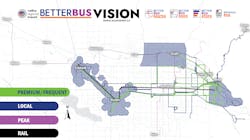VRT Executive Board extends timeline to implement Better Bus Routes
On June 5, the Valley Regional Transit (VRT) Executive Board voted to extend the timeline to implement Better Bus Routes — the agency’s proposed bus network redesign — due to significant community feedback and identification of adequate funding to sustain current levels of service through 2023. VRT plans to implement service changes by summer 2024.
“We’re taking more time to listen and craft a network redesign proposal that moves toward more frequent buses while best reflecting our community’s needs,” said VRT’s CEO Elaine Clegg. “We’ve heard from residents across the Treasure Valley about the value of public transportation and the role it plays in their daily lives, and we’ve had discussions with our funding partners on how critical our services are for the communities they serve.”
During the May comment period, VRT received more than 380 survey responses and 570 individual comments on existing or proposed routes.
The Executive Board set the following schedule at the recommendation of VRT staff to design network updates that best meet community needs:
- June/July: VRT Board of Directors finalizes budgets and reviews feedback to develop the final service plan proposal based on existing hours.
- August/September: VRT Board of Directors introduces the final network proposal on Aug. 7 at the Board of Directors meeting and another public comment period opens. Public hearings on the final proposal will be held in September.
- October: The VRT Executive Board and Board of Directors meet on Oct. 2 to review proposed changes and public comments – and consider the final proposal.
“We’re grateful to our funding partners for their collaboration in helping create positive change, and, thanks to their contributions, we no longer have to plan to reduce total service hours. We now have an opportunity to explore ways to reinvest — through more frequent bus arrivals and innovative ways to provide transit access — without cutting the total amount of service available to the region,” Clegg said.
While public and stakeholder support for a higher-frequency network is strong, VRT hopes to strike a balance between frequency and coverage with the final proposal. Riders can expect routes to be modified or improved without significantly reduced service hours across the system.
“Our goal is to move toward a higher-frequency network while also providing service where and when it is most needed. We are exploring alternatives to intercounty options, the proposed Central Bench and Southeast Boise changes, and solutions to serve high ridership on routes that may not have strong all-day demand, such as Boise’s North End,” Clegg said.
VRT plans for transit services based on funding contributions from cities, counties and universities in the region.
The agency has been working closely with funding partners, including the cities of Boise, Caldwell, Meridian and Nampa, and anticipates enough support to proceed with service improvements without reducing the total number of service hours.
The agency received significant public feedback on the Better Bus concept in April and May this year, and is using the input, alongside ridership data, to guide decisions to develop the final network redesign proposal.
Ridership data
VRT used a variety of metrics to compare routes and prepare service concepts presented in May, including:
- Ridership: Using the ridership metric of “boardings per hour by route,” the agency reviewed routes that were in the bottom 25 percent for ridership for change or reinvestment.
- Proximity to bus stops: VRT examined the number of people and jobs that are within 1/4 mile of a bus stop to measure coverage or the number of individuals that are likely to choose to take transit because it is close to them.
- Proximity to higher-frequency routes: The agency evaluated each service concept by the number of people within 1/4 mile of a bus stop with 15-minute service or better during peak periods and 30-minute service or better throughout the day. This measures the number of people who are more likely to choose to take transit because transit is both close and convenient for their travel needs.
- Service frequency: The agency evaluated the percentage of service hours dedicated to routes with service every 30 minutes or better throughout the day to determine how much of the system is dedicated to higher-frequency routes.
- Potential systemwide ridership: Based on existing route performance, VRT compared the proposed concepts to one another on potential systemwide ridership.
